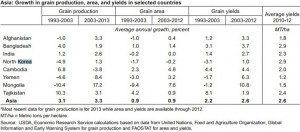UPDATE 1(2014-4-5): According to VOA and Yonhap, the DPRK has submitted a report to the UN World Health Organization for Animal Health (OIE) on the outbreak of FMD:
The Voice of America (VOA) said that Pyongyang submitted a report to the World Organization for Animal Health (OIE), saying that the disease broke out at a cow farm in Cholwon county of Kangwon Province, near the boarder area with South Korea, on March 14.
Nine cows out of 52 were infected with FMD, and one of them died, it added.
It is the first time for North Korea to report FMD in cows. It has notified OIE of outbreak of FMD in pigs in February.
Last week, the U.N. Food and Agriculture Organization (FAO) said the foot-and-mouth disease in North Korea had spread fast, infecting four cows near the border with South Korea.
According to the VOA, the United States, Canada and Mexico will consider providing vaccination to help North Korea upon its request.
ORIGINAL POST (2014-4-3): According to Yonhap:
The U.N. Food and Agriculture Organization (FAO) plans to provide US$400,000 to North Korea to help eradicate the rapidly spreading foot-and-mouth disease there, a U.S. radio report said.
…
The FAO also plans to send quarantine officials to North Korea after finalizing its aid program there, the VOA said.
Foot-and-mouth disease is an infectious and sometimes fatal disease that affects cloven-hoofed animals such as pigs, cattle, deer and sheep.
In February, the North’s state media reported that the country had culled 2,900 pigs as a preventive measure to stop the spread of the disease and buried about 360 others that had died from the disease.
Last week, the FAO said the foot-and-mouth disease in North Korea has spread fast, infecting four cows near the border with South Korea, according to the VOA.
Still, North Korea remained mum for over a month on South Korea’s offer of assistance to contain foot-and-mouth disease.
The North’s silence comes amid tensions on the Korean Peninsula over the exchange of fire by the rival Koreas across their disputed western maritime border, as well as Pyongyang’s threat of a nuclear test.
Pyongyang has also threatened to carry out a “new form” of nuclear test in anger over a United Nations condemnation of its recent ballistic missile launches. North Korea conducted nuclear tests in 2006, 2009 and 2013, drawing international condemnation and U.N. sanctions.
South Korea has vowed to continue humanitarian assistance to the North regardless of political tensions.
Read the full story here:
U.N. to provide US$400,000 to N. Korea over FMD: report
Yonhap
2014-4-3

